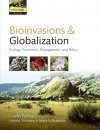![Bioinvasions and Globalization Bioinvasions and Globalization]()
Click to have a closer look
About this book
Contents
Customer reviews
Biography
Related titles
About this book
Bioinvasions and Globalization synthesises our current knowledge of the ecology and economics of biological invasions, providing an in-depth evaluation of the science and its implications for managing the causes and consequences of one of the most pressing environmental issues facing humanity today. Emergent zoonotic diseases such as HIV and SARS have already imposed major costs in terms of human health, whilst plant and animal pathogens have had similar effects on agriculture, forestry, fisheries. The introduction of pests, predators and competitors into many ecosystems has disrupted the benefits they provide to people, in many cases leading to the extirpation or even extinction of native species.
This timely book analyzes the main drivers of bioinvasions - the growth of world trade, global transport and travel, habitat conversion and land use intensification, and climate change - and their consequences for ecosystem functioning. It shows how bioinvasions impose disproportionately high costs on countries where a large proportion of people depend heavily on the exploitation of natural resources. It considers the options for improving assessment and management of invasive species risks, and especially for achieving the international cooperation needed to address bioinvasions as a negative externality of international trade.
Contents
Preface; 1. The problem of biological invasions; PART I - THE DRIVERS OF BIOLOGICAL INVASIONS; 2. Climate change and species' distributions: an alien future?; 3. Climate and invasive species: the limits to climate information; 4. Globalization and invasive alien species: trade, pests and pathogens; 5. Variation in the rate and pattern of spread in introduced species and its implications; 6. Habitats and land-use as determinants of plant invasions in the temperate zone of Europe; PART II - ECONOMICS; 7. If invasive species are "pollutants", should polluters pay?; 8. A model of prevention, detection, and control for invasive species; 9. Second best policies in invasive species management: when are they "good enough"?; 10. Optimal random exploration for trade-related non-indigenous species risk; 11. The role of space in invasive species management; PART III - MANAGEMENT AND POLICY; 12. The impact of invasive alien species on ecosystem services and human well-being; 13. Current and future consequences of invasion by alien species: A case study from South Africa; 14. Invasive plants in tropical human dominated landscapes: need for an inclusive management strategy; 15. Prevention: designing and implementing national policy and management programs to reduce the risks from invasive species; 16. Globalization and bioinvasions: the international policy problem; Appendix 1: Agreement on the Application of Sanitary and Phytosanitary Measures (1995), Articles 1-11; Appendix 2 - International Health Regulations (2005) Articles 2, 5-13; Index
Customer Reviews
Biography
Charles Perrings is Professor of Environmental Economics at Arizona State University, where he directs the ecoSERVICES Group within the College of Liberal Arts and Sciences. He co-chairs (with Shahid Naeem) the ecoSERVICES core project of DIVERSITAS, the international program of biodiversity science. He is the author of numerous books and scientific papers on the economics of biodiversity change.
Harold Mooney is Professor of Biology at Stanford University. His main research area is in global change biology. He has published widely on invasive species and was the founding chair of the Global Invasive Species Programme. He currently chairs the scientific committee for DIVERSITAS, the international program for research in biological diversity.
Mark Williamson is Professor of Biology (Emeritus) at the University of York. He is a population biologist who founded the department of biology at York in 1963 and who has been involved with biological invasion research since the first SCOPE programme (1982-89).




































